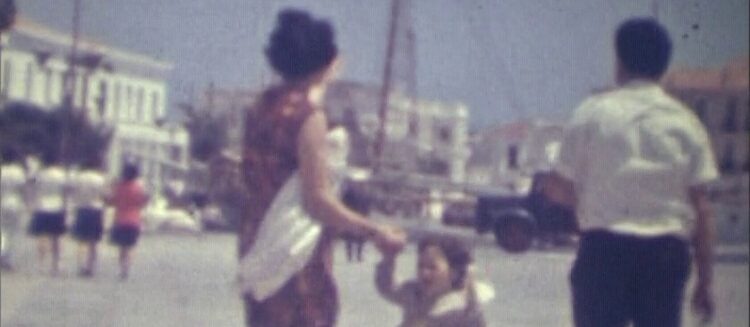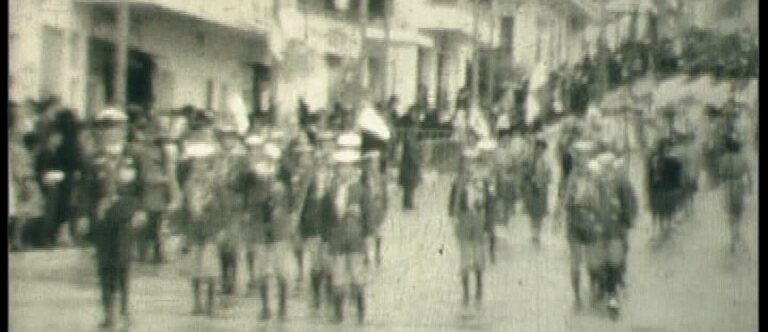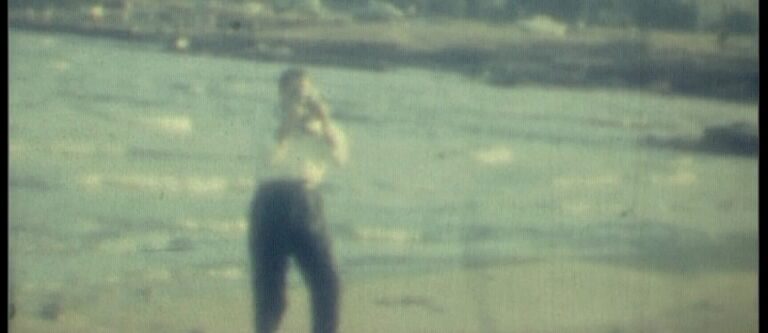Syros International Film Festival (SIFF)
Peripheral Vision

The Syros International Film Festival runs a programme titled Peripheral Vision that presented new works by artists based on materials they have found in the Historical Archive of Syros. Jacob Moe, the Festival’s co-founder, talks with Angeliki Psilopoulou, who heads the Archive about how this process developed and why archives like the Rigopoulos Film Collection have an importance that goes far beyond their narrower regional context.
Jacob Moe
[In Peripheral Vision] we’ve been thinking a lot about the notion of the archive, and how it serves as a resource for repurposing and creating narratives. I wonder if you could tell us a few words about this based on your experience here at the Historical Archive of Syros.
Angeliki Psilopoulou
An “archive” is a broad term. It’s not only a service, or something that is produced, something that has some relation with the broader and administrative history of this place; it can also be something found in someone’s house. It may well be a family archive, which also comprises a part of social history. We ourselves are social beings, and the things we accumulate in our houses are part of a cumulative total.
I believe deeply in the notion of the archive; photographs, documents that a family might keep, such as the Rigopoulos archive of photo negatives and films… [he himself] was an obsessive photographer. Today, these things take on another dimension, and depict a particular era. You never know where and when these materials may be used, because we cannot predict the needs of future researchers. Archives are important in that they illuminate aspects of the past.
JM
Yes—that’s precisely what has happened in this workshop, where we’ve provided the Rigopoulos film collection, a sonic archive from Syros Sound Meetings and film archives from the Cairo Cimatheque to the nine participating artists/teams. Each of them came away with an entirely different take.
AP
That’s how it is. That’s the attraction of it, and the difference. The different approaches people bring based on their backgrounds, and their aims. It’s about context, but also about purpose, about what someone wants to do with it. That’s where the beauty lies.
JM
Taking the Rigopoulos collection as an example, how did it come to be a part of the Historical Archive here?
AP
One summer, his nephew, Thanopoulos the dentist, showed up and told me that they’d decided with his cousin, who was Rigopoulos’s daughter, to give it to us. He must be a member of the Syriot Association in Athens, and probably heard about us from various members that have contributed to our effort, or come here for research. In any case he clearly valued the archive, and came here with his mind made up to give us the films […] I knew Mr. Rigopoulos himself, we knew one another from all the way back in high school. A very dear man.
JM
The Rigopoulos films constitute an intimate portrait of a family, but also a historical snapshot of Syros. The parades, the building facades, the styles of dress—they all convey a certain context […] Although this is primarily a historical, document-based collection, I can see you also have experience with the audiovisual realm, as well as with oral history.
AP
During an exhibition we’d organized on the occasion of the eighty year anniversary of the Greco-Turkish war of 1919-1922 […] we interviewed first and second generation immigrants. The first generation was really getting up there in age, and sometimes we didn’t manage to get to them in time, which was truly unfortunate […] After, this material was digitized and uploaded to a platform dedicated to the immigrants of the entire Mediterranean region. Syros was a huge center for immigration; Hermoupolis is a city of refugees. There was a first wave in 1822 made up of islanders from Chios and Psara, then in 1824 from Kasos. Then came a second wave from Asia Minor, 100 years later.
JM
Can you also tell us a bit about how you go about incorporating new materials into the archive? What is that process like?
AP
The Historical Archive reports to the Ministry of Education, and is tasked with identifying archives and visiting them in order to appraise their value. If they don’t have value – if they already exist as duplicates in some form, for example, we issue a directive to destroy them. If not, we accept the archive, document it, register it in our archival register, and then include it in our electronic inventory. Then we begin to organize and process it. The origin of the archive usually dictates the organizational structure we use: for example, in the case of the Municipal Archive, it is organized according to the categories of administrative service, civil registry, etc. So we follow that structure, inserting numbered folders into it, assigning descriptions […] and now, with our electronic archival platform, we also upload it there.
Apart from that, we field requests from individuals, government services, etc. […] It’s really splendid work, you never get weary of it. It’s a journey through time, but at the same time an introspective journey. We’ve seen it all over the years: people from all around the world coming here and finding information about their long lost relatives… that’s the social dimension of this all. But there’s of course the scientific dimension, and the personal dimension too, at least in my experience.
The above text is an edited, condensed version of a conversation held at the Historical Archive of Syros – GAK, between Jacob Moe, co-founder of SIFF and Angeliki Psilopoulou, head of the Archive. In the context of SIFF’s Peripheral Vision workshop supported by the Goethe Institut-Athen and led by filmmaker Tamer El Said, the Historical Archive of Syros has provided three discs of digitized super 8 film footage shot between 1966-1972 by G. Rigopoulos, for use by the workshop’s selected filmmakers/creative teams. The workshop began in September 2020 and will conclude at the ninth edition of SIFF, held from July 22-26 2021, where the final projects will be presented.


